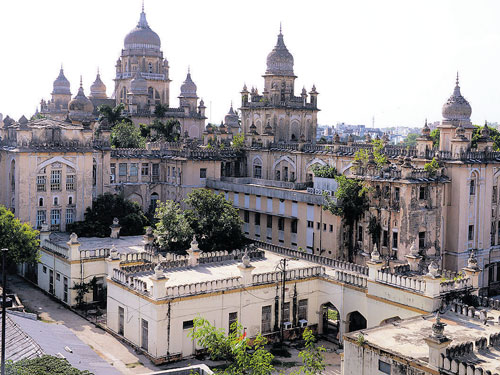
Telangana’s penchant for demolition persists: Osmania Hospital to be razed
If any government talks about constructing a hospital in the time of pandemic, it should not come as a surprise. But, demolishing an existing hospital, amidst a deepening public health crisis, is not what one expects from any government.

If any government talks about constructing a hospital in the time of pandemic, it should not come as a surprise. But, demolishing an existing hospital, amidst a deepening public health crisis, is not what one expects from any government.
However, this is exactly what the Telangana Rashtra Samithi (TRS) government in Telangana is planning to do.
It has proposed to demolish an iconic, 150-year-old Osmania General Hospital (OGH) building in the heart of Hyderabad, which is in poor condition following neglect by successive governments over decades. However, heritage activists have opposed the move saying the government should preserve the main building as it is part of the city’s rich heritage.
This notified heritage building, spread over 26 acres with 1,100 beds and 9 operation theatres, was in the news last month, with videos of the hospital wards inundated by rainwater going viral on the social media.
The ‘Brand Hyderabad’ took a severe beating as images of the pathetic conditions at the hospital became a talk point in the media. As sewage and rainwater flooded the wards, the patients raised concerns over their safety.
The visuals of patients sitting on beds while the ward was filled with ankle-deep water were repeatedly highlighted by news channels, triggering outrage among health professionals, citizens, and politicians. Parts of the ceiling of the hospital have also been giving way for the past few years.
Following widespread criticism from opposition parties and civil society, State Director of Medical Education K Ramesh Reddy directed the hospital authorities to vacate the main building and shift patients to the other blocks.
The President of Telangana Medical and Health Gazetted Officers’ Association Jupally Rajender said the process of shifting the patients and offices of the doctors in the OGH building was completed.
“The building is in a dilapidated condition and is crumbling. We can’t take the risk of continuing to operate from the premises,” Rajender said.
Old proposal
Chief Minister K. Chandrasekhar Rao had, in 2015, proposed the demolition of the OGH building, built during the rule of the last Nizam of Hyderabad, Mir Osman Ali Khan, and construct a world-class hospital building complex in that place. But, he backed out then following strong resistance from heritage activists.
The proposal has now been revived. “We will go ahead with the demolition. It is a question of safety of the employees,” the official sources said.
The decision was prompted by the demand from the OGH Doctors Association that the building be pulled down and a new one be constructed in its place.
The doctors have cited incidents where chunks of plaster fell off as well. In November 2018, junior doctors had launched a 75-day strike, asking the government to declare the building not fit for use.
Designed by British architect Vincent Jerome Esch, the OGH, located on the banks of Musi river, is a fine example of Osmanian style of Indo-Saracenic genre of architecture. It is categorised as a heritage structure in the Hyderabad Metropolitan Development Association (HMDA) listing and is protected under the Heritage Regulations of HMDA.
The building has a grand dome on its central tower with smaller cupolas and domed pavilions on its corners and stair wells. Located at Afzal Gunj, the building is part of the city’s heritage and skyline.
Heritage activists want the main building to be repaired and preserved, and a new hospital constructed around it. “A heritage building can co-exist with new health infrastructure. OGH building is part of our history and culture. We must preserve it. The building is protected under Regulation 13 of Hyderabad Urban Development Authority Zoning Regulations and also under Heritage Regulations of HMDA,” says Anuradha Reddy, Convenor of Indian National Trust for Art and Cultural Heritage (INTACH), an NGO.
Structural study
Soon after the government made the demolition proposal public in 2015, the INTACH conducted a structural stability and safety study and presented a comprehensive report to the government over its safety.
The study concluded that the heritage building is structurally safe and can be made safe for another century, if properly maintained after repairs, restoration, and retrofitting.
It was suggested that the main building be used for outpatient clinics, administrative and support services.
The heritage activists contended that the government should go for constructing new building complexes in the remaining 25 acres of land by removing existing structures like the residential quarters, the paying room block, the nursing quarters, nursing hostels and laundry area, leaving the heritage building untouched.
Online petition
Several activists have launched an online petition to save the heritage structure. They are also demanding that the government seal the main OGH building and ensure that no one is allowed inside to prevent any further damage. Along with the construction of a new hospital building, activists are demanding that the government invest in restoration and preservation of the heritage building.
However, the government justified the move on the ground that the structure was unsafe. “The people who are opposing the construction of a new building should remember that Nizam of Hyderabad had constructed the hospital as a health facility to serve the people and not to project it as a monument,” Medical and Health Minister Etela Rajender said.
Already, the ongoing project to demolish the 25-acre Secretariat complex, overlooking the picturesque Hussainsagar lake, has raised the hackles of heritage activists. A new secretariat complex is being built at a cost of ₹400 crore.
Along with several other blocks, a 19th century palace, located inside the secretariat complex, has been razed to the ground. The Saifabad palace was built in 1888 by the sixth Nizam of Hyderabad, Mahboob Ali Pasha. It was a two-storey building, built in classical European style.


